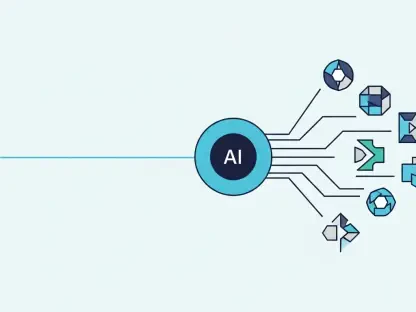Setting the Stage for a Digital Revolution in Public Sector Tech
Imagine a world where federal agencies operate with the speed and precision of a tech startup, leveraging artificial intelligence to streamline everything from disaster response to regulatory compliance. This vision is rapidly becoming reality as tech giants like Google step into the arena of government partnerships with transformative AI solutions. The recent announcement on August 21, 2025, of Google’s Gemini AI tools tailored for US government use marks a pivotal moment in the public sector tech market. This analysis aims to dissect the burgeoning market of AI adoption in government, exploring key trends, competitive dynamics, and future projections. The significance lies not only in the immediate impact on federal efficiency but also in the broader implications for tech companies seeking to carve out a share of this lucrative and strategically vital sector.
Diving Deep into Market Trends and Projections
The Surge of AI Adoption in Government Operations
The integration of AI into government workflows represents one of the fastest-growing segments in the public sector tech market. Google’s launch of “Gemini for Government,” a comprehensive suite of AI and cloud computing services priced at less than a dollar, underscores a strategic push toward affordability and accessibility. This package, which includes tools for video generation, image creation, and autonomous task management, targets a wide array of federal needs, from administrative efficiency to creative problem-solving. According to insights from the General Services Administration, the adoption of such tools could accelerate digital transformation across agencies by at least 30% over the next two years, from 2025 to 2027. The market potential here is immense, as federal budgets increasingly allocate funds for tech modernization, creating fertile ground for innovation.
The trend is further fueled by a growing recognition among government leaders of AI’s capacity to address longstanding inefficiencies. Unlike previous tech waves like cloud computing, which focused on storage and basic automation, AI offers predictive analytics and decision-making capabilities that can fundamentally alter operational models. However, barriers such as data security concerns and a lack of trained personnel pose significant challenges to rapid scaling. The market must evolve to address these hurdles through tailored training programs and robust cybersecurity frameworks, ensuring that AI tools are both effective and trustworthy in sensitive environments.
Competitive Landscape: Google vs. OpenAI in the Race for Contracts
Competition in the government AI market is heating up, with major players like Google and OpenAI vying for dominance through aggressive pricing and specialized offerings. Just weeks before Google’s announcement, OpenAI introduced a business-focused version of ChatGPT for federal use at a nominal cost of $1 per year, alongside a substantial $200 million contract with the Department of Defense for generative AI applications in cyber defense and administrative tasks. This move highlights OpenAI’s strategy of targeting niche, high-impact areas, particularly in military contexts, which could yield long-term strategic advantages. In contrast, Google’s Gemini suite adopts a broader, full-stack approach, aiming to serve diverse agency needs with versatile tools.
Analyzing market share potential, Google’s wide-ranging capabilities might appeal to a larger number of agencies seeking comprehensive solutions, potentially capturing a significant portion of non-defense contracts. OpenAI, however, could dominate in specialized sectors like defense, where precision and customization are paramount. Both companies are leveraging near-free services as entry points, a tactic that could reshape pricing models industry-wide, pushing smaller competitors to either innovate rapidly or risk obsolescence. The competitive dynamic suggests a bifurcated market emerging, split between broad-spectrum providers and niche specialists, with success hinging on adaptability to stringent government regulations.
Emerging Opportunities and Future Market Growth
Looking ahead, the government AI market is poised for exponential growth, driven by technological advancements and evolving policy frameworks. Projections indicate that by 2027, federal spending on AI solutions could surpass $5 billion annually, fueled by demand for tools tailored to specific functions like emergency management and public health monitoring. Innovations in natural language processing and machine learning are expected to enhance platforms like Gemini, enabling more intuitive interactions and complex problem-solving. Additionally, regulatory shifts toward stricter data privacy standards will likely spur the development of secure, compliant AI systems, creating opportunities for tech firms that can navigate this landscape effectively.
Smaller tech companies and startups also stand to gain traction by focusing on underserved niches within the public sector, such as state and local government needs, which remain largely untapped by giants like Google and OpenAI. Partnerships between these smaller entities and established players could foster innovation, blending agility with scale. The market’s trajectory suggests a future where AI becomes as integral to government operations as traditional software, transforming service delivery and policy implementation. Keeping an eye on these trends will be crucial for stakeholders aiming to capitalize on this digital wave.
Reflecting on Insights and Strategic Pathways Forward
Looking back, the entry of Google’s Gemini AI tools into the US government sphere on August 21, 2025, alongside OpenAI’s parallel initiatives, marked a defining shift in the public sector technology market. This analysis revealed a landscape brimming with opportunity, driven by competitive pricing, diverse offerings, and a pressing need for operational efficiency in federal agencies. The competitive interplay between broad-spectrum solutions and niche applications underscored a market in flux, with significant growth potential over the coming years.
For tech companies, the strategic takeaway is clear: prioritize adaptability by aligning solutions with government-specific requirements, particularly in security and compliance. Investing in partnerships with agencies to co-develop tailored tools could solidify market presence. Government leaders, meanwhile, need to focus on building internal capacity through training and oversight mechanisms to maximize AI’s benefits. As this market continues to evolve, staying ahead requires a proactive stance—anticipating regulatory changes and fostering collaborations that bridge the gap between public needs and private innovation. The path forward promises transformation, provided stakeholders navigate it with foresight and precision.









